This month’s open thread. Usual rules apply.
Blog – realclimate.org – All Posts
There was no pause
I think that the idea of a pause in the global warming has been a red herring ever since it was suggested, and we have commented on this several times here on RC: On how data gaps in some regions (eg. the Arctic) may explain an underestimation of the recent warming. We have also explained how natural oscillations may give the impression of a faux pause. Now, when we know the the global mean temperature for 2016, it’s even more obvious.
Easterling and Wehner (2009) explained that it is not surprising to see some brief periods with an apparent decrease in a temperature record that increases in jumps and spurts, and Foster and Rahmstorf (2012) showed in a later paper how temperature data from the most important observations show consistent global warming trends when known short-term influences such as El Niño Southern oscillation (ENSO), volcanic aerosols and solar variability are accounted for.
A recent paper by Hausfather et al. (2017) adds little new to our understanding, although it confirms that there has not been a recent “hiatus” in the global warming. However, if there are doubts about a physical condition, then further scientific research is our best option for establishing the facts. This is exactly what this recent study did.
The latest findings confirm the results of Karl et al. 2015 from the National Oceanic Atmospheric Administration (NOAA), which Gavin described in a previous post here on RC. The NOAA analysis received unusual attention because of the harassment it drew from the chair of the US House Science Committee and the subpoena demand for emails.
[Read more…] about There was no pause
References
- D.R. Easterling, and M.F. Wehner, "Is the climate warming or cooling?", Geophysical Research Letters, vol. 36, 2009. http://dx.doi.org/10.1029/2009GL037810
- G. Foster, and S. Rahmstorf, "Global temperature evolution 1979–2010", Environmental Research Letters, vol. 6, pp. 044022, 2011. http://dx.doi.org/10.1088/1748-9326/6/4/044022
- Z. Hausfather, K. Cowtan, D.C. Clarke, P. Jacobs, M. Richardson, and R. Rohde, "Assessing recent warming using instrumentally homogeneous sea surface temperature records", Science Advances, vol. 3, 2017. http://dx.doi.org/10.1126/sciadv.1601207
- T.R. Karl, A. Arguez, B. Huang, J.H. Lawrimore, J.R. McMahon, M.J. Menne, T.C. Peterson, R.S. Vose, and H. Zhang, "Possible artifacts of data biases in the recent global surface warming hiatus", Science, vol. 348, pp. 1469-1472, 2015. http://dx.doi.org/10.1126/science.aaa5632
2016 Temperature Records
To nobody’s surprise, all of the surface datasets showed 2016 to be the warmest year on record.
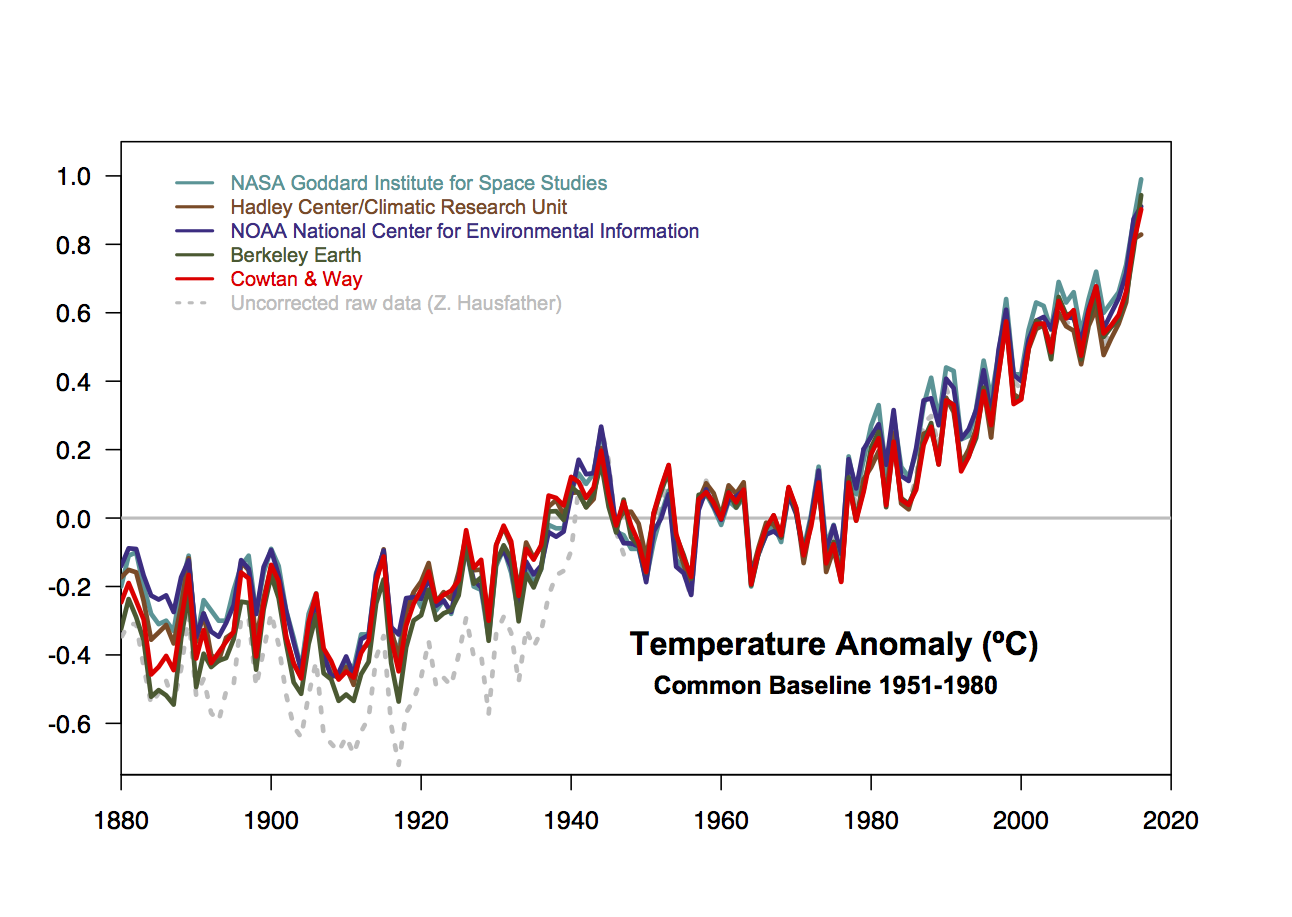
Barely more surprising is that all of the tropospheric satellite datasets and radiosonde data also have 2016 as the warmest year.
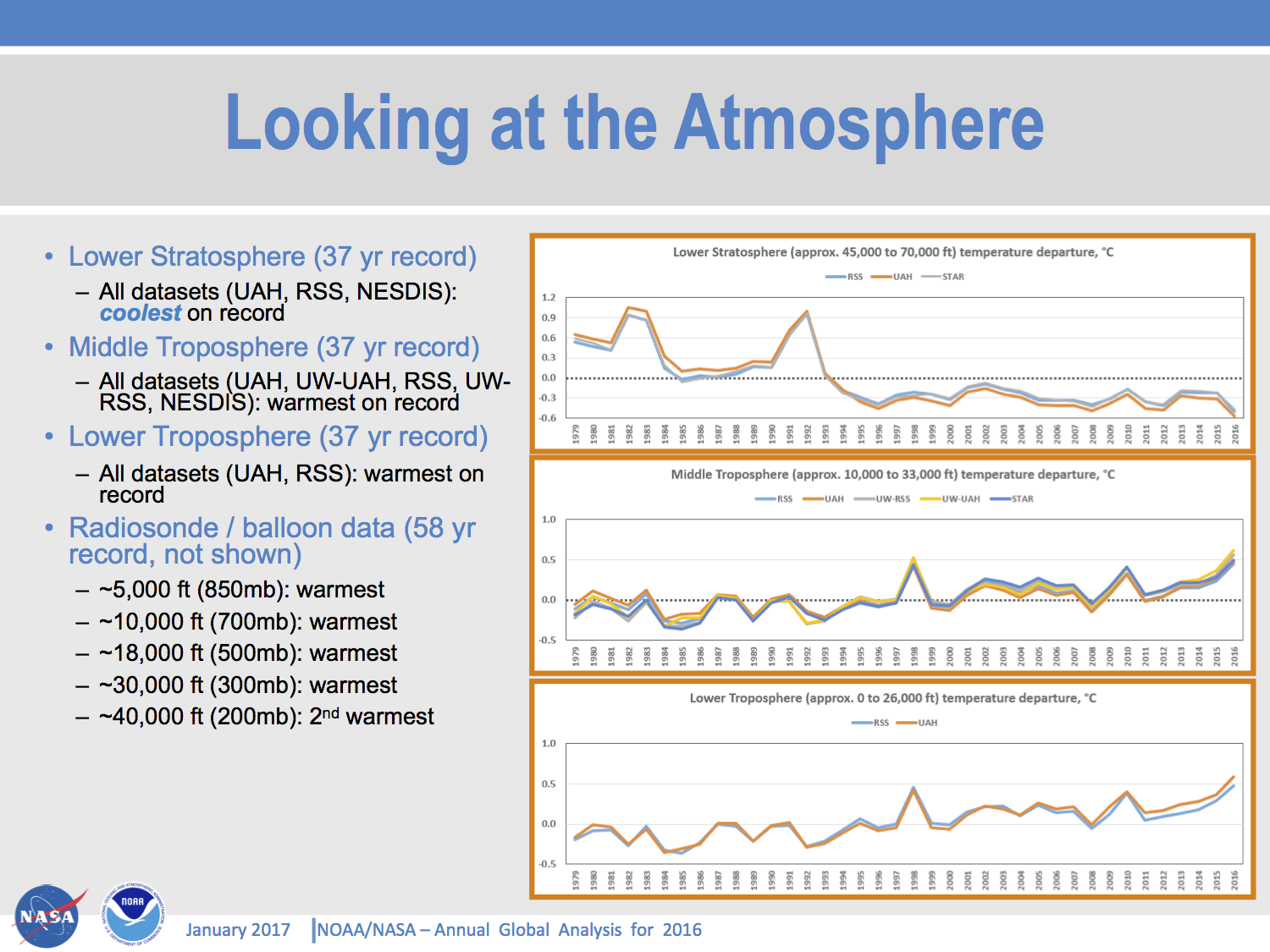
Coming as this does after the record warm 2015, and (slightly less definitively) record warm 2014, the three records in row might get you to sit up and pay attention.
Non-condensable Cynicism in Santa Fe
Guest Post by Mark Boslough
The Fourth Santa Fe Conference on Global & Regional Climate Change will be held on Feb 5-10, 2017. It is the fourth in a series organized and chaired by Petr Chylek of Los Alamos National Laboratory (LANL) and takes place intervals of 5 years or thereabouts. It is sponsored this year by LANL’s Center for Earth and Space Science and co-sponsored by the American Meteorological Society. I attended the Third in the series, which was held the week of Oct 31, 2011. I reported on it here in my essay “Climate cynicism at the Santa Fe conference”.
In that report, I described my experiences and interactions with other attendees, whose opinions and scientific competence spanned the entire spectrum of possibility. Christopher Monckton represented one extreme end-member, with no scientific credibility, total denial of facts, zero acknowledgment of uncertainty in his position, and complete belief in a global conspiracy to promote a global warming fraud. At the opposite end were respected professional climate scientists at the top of their fields, such as Richard Peltier and Gerald North. Others, such as Fred Singer and Bill Gray, occupied different parts of the multi-dimensional phase space, having credentials but also having embraced denial—each for their own reasons that probably didn’t intersect.

For me, the Third Conference represented an opportunity to talk to people who held contrary opinions and who promoted factually incorrect information for reasons I did not understand. My main motivation for attending was to engage in dialogue with the contrarians and deniers, to try to understand them, and to try to get them to understand me. I came away on good terms with some (Bill Gray and I bonded over our common connection to Colorado State University, where I was an undergraduate physics student in the 1970s) but not so much with others.
I was ambitious and submitted four abstracts. I and my colleagues were pursuing uncertainty quantification for climate change in collaboration with other DOE labs. I had been collaborating on several approaches to it, including betting markets, expert elicitation, and statistical surrogate models, so I submitted an abstract for each of those methods. I had also been working with Lloyd Keigwin, a senior scientist and oceanographer at Woods Hole Oceanographic Institution and another top-of-his-field researcher. We submitted an abstract together about his paleotemperature reconstruction of Sargasso Sea surface temperature, which is probably the most widely reproduced paleoclimate time series other than the Mann et al. “Hockey Stick” graph. I had updated it with modern SST measurements, and in our abstract we pointed out that it had been misused by contrarians who had removed some of the data, replotted it, and mislabeled it to falsely claim that it was a global temperature record showing a cooling trend. The graph continues to make appearances. On March 23, 2000, ExxonMobil took out an advertisement in the New York Times claiming that global warming was “Unsettled Science”. The ad was illustrated with a doctored version of Lloyd’s graph (the inconvenient modern temperature data showing a warming trend had been removed). This drawing was very similar to one that had been generated by climate denier Art Robinson and his son for a Wall Street Journal editorial a couple months earlier. It wasn’t long before other distorted versions started showing up elsewhere, such as the Albuquerque Journal opinion page. The 2000 ExxonMobil version was just entered into the Congressional Record last week by Senator Tim Kaine during the Tillerson confirmation hearings.
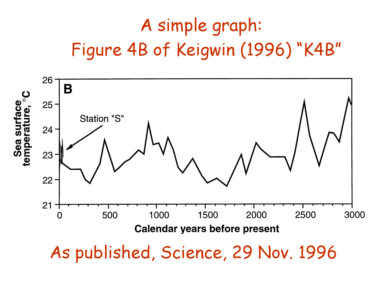
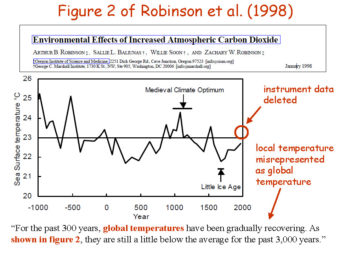
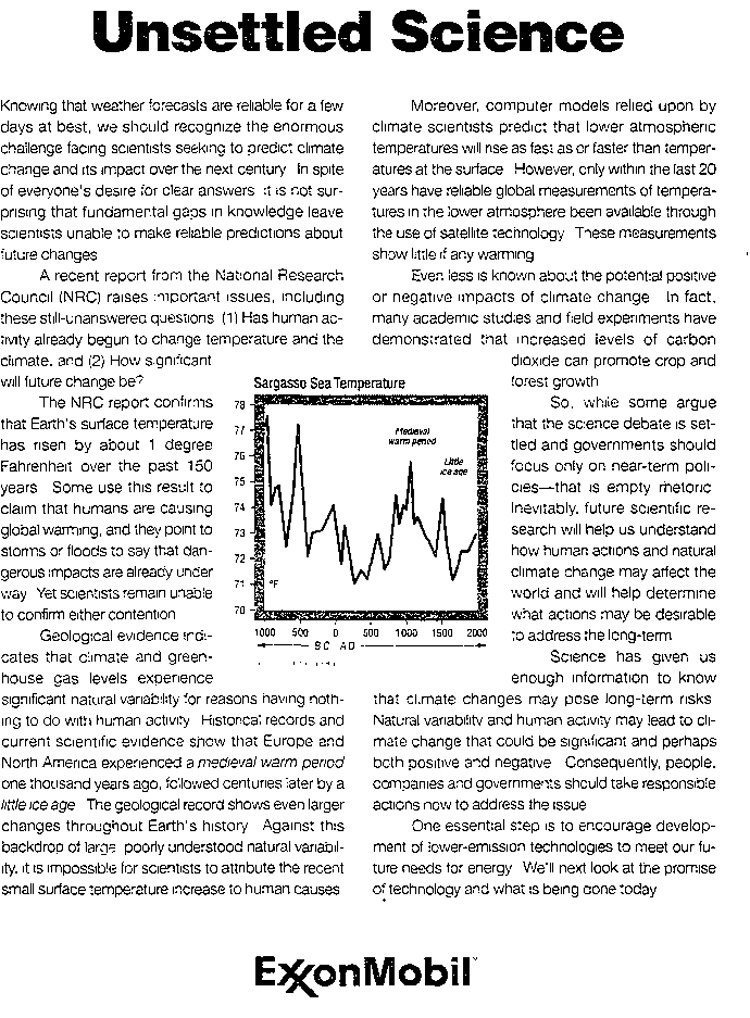
In 2011, my abstracts on betting, expert elicitation, and statistical models were all accepted, and I presented them. But the abstract that Lloyd and I submitted was unilaterally rejected by Chylek who said, “This Conference is not a suitable forum for [the] type of presentations described in [the] submitted abstract. We would accept a paper that spoke to the science, the measurements, the interpretation, but not simply an attempted refutation of someone else’s assertions (especially when made in unpublished reports and blog site).” The unpublished report he spoke of was the NIPCC/Heartland Institute report, which Fred Singer was there to discuss. After the conference, I spoke to one of the co-chairs about the reasons for the rejection. He said that he hadn’t seen it and did not agree with the reasons for the rejection. He encouraged Lloyd and me to re-submit it again for the 4th conference. So we did. Lloyd sent the following slightly-revised version on January 4
Misrepresentations of Sargasso Sea Temperatures by Global Warming Doubters
Keigwin (Science 274:1504–1508, 1996) reconstructed the SST record in the northern Sargasso Sea to document natural climate variability in recent millennia. The annual average SST proxy used δ18O in planktonic foraminifera in a radiocarbon-dated 1990 Bermuda Rise box core. Keigwin’s Fig. 4B (K4B) shows a 50-year-averaged time series along with four decades of SST measurements from Station S near Bermuda, demonstrating that at the time of publication, the Sargasso Sea was at its warmest in more than 400 years, and well above the most recent box-core temperature. Taken together, Station S and paleotemperatures suggest there was an acceleration of warming in the 20th century, though this was not an explicit conclusion of the paper. Keigwin concluded that anthropogenic warming may be superposed on a natural warming trend.
In a paper circulated with the anti-Kyoto “Oregon Petition,” Robinson et al. (“Environmental Effects of Increased Atmospheric Carbon Dioxide,” 1998) reproduced K4B but (1) omitted Station S data, (2) incorrectly stated that the time series ended in 1975, (3) conflated Sargasso Sea data with global temperature, and (4) falsely claimed that Keigwin showed global temperatures “are still a little below the average for the past 3,000 years.” Slight variations of Robinson et al. (1998) have been repeatedly published with different author rotations. Various mislabeled, improperly-drawn, and distorted versions of K4B have appeared in the Wall Street Journal, in weblogs, and even as an editorial cartoon—all supporting baseless claims that current temperatures are lower than the long term mean, and traceable to Robinson’s misrepresentation with Station S data removed. In 2007, Robinson added a fictitious 2006 temperature that is significantly lower than the measured data. This doctored version of K4B with fabricated data was reprinted in a 2008 Heartland Institute advocacy report, “Nature, Not Human Activity, Rules the Climate.”
On Jan. 9, Lloyd and I got a terse rejection from Chylek: “Not accepted. The committee finding was that the abstract did not indicate that the presentation would provide additional science that would be appropriate for the conference.”
I had also submitted an abstract with Stephen Lewandowsky and James Risbey called “Bets reveal people’s opinions on climate change and illustrate the statistics of climate change,” and a companion poster entitled “Forty years of expert opinion on global warming: 1977-2017” in which we proposed to survey the conference attendees:
Forecasts of anthropogenic global warming in the 1970s (e.g. Broecker, 1975, Charney et al., 1979) were taken seriously by policy makers. At that time, climate change was already broadly recognized within the US defense and intelligence establishments as a threat to national and global security, particularly due to climate’s effect on food production. There was uncertainty about the degree of global warming, and media-hyped speculation about global cooling confused the public. Because science-informed policy decisions needed to be made in the face of this uncertainty, the US Department of Defense funded a study in 1977 by National Defense University (NDU) called “Climate Change to the Year 2000” in which a panel of experts was surveyed. Contrary to the recent mythology of a global cooling scare in the 1970s, the NDU report (published in 1978) concluded that, “Collectively, the respondents tended to anticipate a slight global warming rather than a cooling”.
Despite the rapid global warming since 1977, this subject remains politically contentious. We propose to use our poster presentation to survey the attendees of the Fourth Santa Fe Conference on Global and Regional Climate Change and to determine how expert opinion has changed in the last 40 years.
I had attempted a similar project at the 3rd conference with my poster “Comparison of Climate Forecasts: Expert Opinions vs. Prediction Markets” in which my abstract proposed the following: “As an experiment, we will ask participants to go on the record with estimates of probability that the global temperature anomaly for calendar year 2012 will be equal to or greater than x, where x ranges in increments of 0.05 °C from 0.30 to 1.10 °C (relative to the 1951-1980 base period, and published by NASA GISS).” I included a table for participants to fill in, and even printed extra sheets to tack up on the board with my poster so I could compile them and report them later.
This idea was a spinoff of work I had presented at an unclassified session of the 2006 International Conference on Intelligence Analysis on my research in support of the US intelligence community for which a broad spectrum of opinion must be used to generate an actionable consensus with incomplete or conflicting information. That was certainly the case in Santa Fe, where there were individuals (e.g. Don Easterbrook) who were going on record with predictions of global cooling. By the last day of the conference, several individuals had filled in the table with their probabilistic predictions and I decided to leave my poster up until the end of the day, which was how long they could be displayed according to the conference program. I wanted to plug it during my oral presentation on prediction markets so that I could get more participation. Unfortunately when I returned to the display room, my poster had been removed. Hotel employees did not know where it was, and the diverse probability estimates were lost.
This year I would be more careful, as announced in my abstract. But the committee would have no part of it. On Jan 10 I got my rejection letter:
I regret to inform you that we have decided to decline this submission.
Based on our consideration of the abstract and plan, it is our view that designing a survey that accurately elicits expert opinion requires special expertise as the answers can depend on how the questions are asked. No indication of such expertise was presented in the abstract itself or found based on examination of your publication record.
A further concern dealt with the proposed comparison with opinion elicited at a different time from a different community by a different method that might allow one to “determine how expert opinion has changed in the last 40 years.”
Concern was raised also over how one might legitimately transform the results of such a poll into “into probabilistic global warming projections.”
Although we cannot accept this poster, we certainly look forward to your active participation in the Conference.
Of the hundreds of abstracts I’ve submitted, this is the only conference that’s ever rejected one. As a frequent session convener and program committee chair myself, I am accustomed to providing poster space for abstracts that I might question, misunderstand, or disagree with. It has never occurred to me to look at the publication list of a poster presenter, But if I were to do that, I would be more thorough and look other information, including their coauthors’ publication lists and CVs as well. In this case, the committee might have discovered more than a few papers by one of them on the subject, such as Risbey and Kandlikar (2002) “Expert Assessment of Uncertainties in Detection and Attribution of Climate Change” in the Bulletin of the American Meteorological Society, or that Prof. Risbey was a faculty member in Granger Morgan’s Engineering and Public Policy department at CMU for five years, a place awash in expert elicitation of climate (I sent my abstract to Prof. Morgan–who I know from my AGU uncertainty quantification days–for his opinion before submitting it to the conference).
At the very least, I would look at the previous work cited in the abstract. The committee would not have been puzzled by how to transform survey data into probabilistic projections if they had done so. They would have learned that the 1978 NDU study we cited had already established the methodology we were proposing to use. The NDU “Task I” was “To define and estimate the likelihood of changes in climate during the next 25 years…” using ten survey questions described in Chapter One (Methodology). The first survey question was on average global temperature. So the legitimacy of the method we were planning to use was established 40 years ago.
I concluded after the 3rd Santa Fe conference that cynicism was the only attribute that was shared by the minority of attendees who were deniers, contrarians, publicity-seekers, enablers, or provocateurs. I now think that cynicism has something in common with greenhouse gases. Cynicism begets cynicism, to the detriment of society. There are natural-born cynics, and if they turn the rest of us into cynics then we are their amplifiers, just like water vapor is an amplifier of carbon dioxide’s greenhouse effect. We become part of a cynical feedback loop that generates distrust in science and the scientific method. I refuse to let that happen. I might have gotten a little steamed by an unfair or inappropriate rejection, but I’ve cooled off and my induced cynicism has condensed now. I am not going to assume that everyone is a cynic just because of a couple of misguided and misinformed decisions.
As President Obama said in his farewell address, “If you’re tired of arguing with strangers on the Internet, try talking with one of them in real life.” So if you are attending the Santa Fe conference, I would like to meet with you. If you are flying into Albuquerque, where I live, drop me a line. Or meet me for a drink or dinner in Santa Fe. I can show you why Lloyd’s research really does provide additional science that is relevant to the conference. I can try to convince you that prediction markets are indeed superior to expert elicitation in their ability to forecast climate change. Maybe I can even talk you into going on record with your own probabilistic global warming forecast!
The NASA data conspiracy theory and the cold sun
When climate deniers are desperate because the measurements don’t fit their claims, some of them take the final straw: they try to deny and discredit the data.
The years 2014 and 2015 reached new records in the global temperature, and 2016 has done so again. Some don’t like this because it doesn’t fit their political message, so they try to spread doubt about the observational records of global surface temperatures. A favorite target are the adjustments that occur as these observational records are gradually being vetted and improved by adding new data and eliminating artifacts that arise e.g. from changing measurement practices or the urban heat island effect. More about this is explained in this blog article by Victor Venema from Bonn University, a leading expert on homogenization of climate data. And of course the new paper by Hausfather et al, that made quite a bit of news recently, documents how meticulously scientists work to eliminate bias in sea surface temperature data, in this case arising from a changing proportion of ship versus buoy observations. [Read more…] about The NASA data conspiracy theory and the cold sun
The underestimated danger of a breakdown of the Gulf Stream System
A new model simulation of the Gulf Stream System shows a breakdown of the gigantic overturning circulating in the Atlantic after a CO2 doubling.
A new study in Science Advances by Wei Liu and colleagues at the Scripps Institution of Oceanography in San Diego and the University of Wisconsin-Madison has important implications for the future stability of the overturning circulation in the Atlantic Ocean. They applied a correction to the freshwater fluxes in the Atlantic, in order to better reproduce the salt concentration of ocean waters there. This correction changes the overall salt budget for the Atlantic, also changing the stability of the model’s ocean circulation in future climate change. The Atlantic ocean circulation is relatively stable in the uncorrected model, only declining by about 20% in response to a CO2 doubling, but in the corrected model version it breaks down completely in the centuries following a CO2 doubling, with dramatic consequences for the climate of the Northern Hemisphere. [Read more…] about The underestimated danger of a breakdown of the Gulf Stream System
Unforced Variations: Jan 2017
A trigger action from sea-level rise?
Can a rising sea level can act as a boost for glaciers calving into the sea and trigger a surge of ice into the oceans? I finally got round to watch the documentary Chasing Ice over the Christmas and New Year’s break, and it made a big impression. I also was left with this question after watching it.
Climatology and meteorology are your friends
The Norwegian Meteorological institute has celebrated its 150th anniversary this year. It was founded to provide weather data and tentative warnings to farmers, sailors, and fishermen. The inception of Norwegian climatology in the mid-1800s started with studies of geographical climatic variations to adapt important infrastructure to the ambient climate. The purpose of the meteorology and climatology was to protect lives and properties.
[Read more…] about Climatology and meteorology are your friends
What has science done for us?
Where would we be without science? Today, we live longer than ever before according to the Royal Geographical Society, thanks to pharmaceutical, medical, and health science. Vaccines saves many lives. Physics and electronics have given us satellites, telecommunications, and the Internet. You would not read this blog without them. Chemistry and biology have provided use with all sorts of products, food, and enabled the agricultural (“green”) revolution enhancing our crop yields. The science of evolution and natural selection explains the character of ecosystems, and modern meteorology saves lives and help us safeguard our properties.